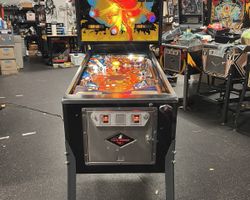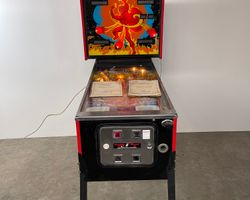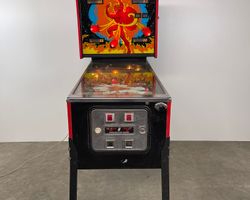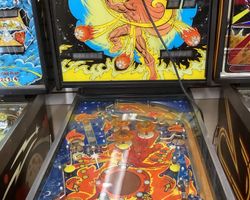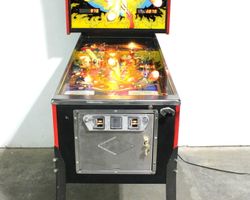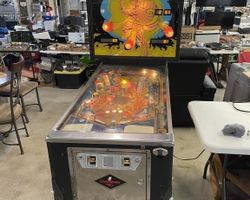Fireball Classic
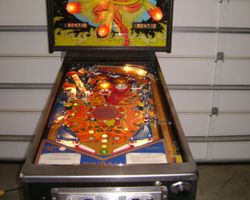
Average Prices: USD $300 to $1,700
Produced: Febuary, 1985
Production Run: 2,000 units
Machine Type: Solid State Electronic
MPU: Bally MPU A080-91638-D000 (6802)
Players: 4
Design by: George Christian
Art by: Doug Watson
Fireball Classic, a solid-state pinball machine from Bally Manufacturing Co., emerged in February 1985 as a reimagining of one of pinball's seminal designs. Released under the Bally Midway banner, this machine aimed to bring the chaotic energy of the 1972 electro-mechanical "Fireball" into the modern electronic era. Bally produced 2,000 units of the Fireball Classic, a modest run that nonetheless cemented its place in the lineage of this distinctive pinball concept.
The original "Fireball" was a benchmark for its era, and the 1985 "Fireball Classic" carried much of its spirit forward, translating the core mechanics and fantasy theme into a solid-state platform. George Christian and Ted Zale, who had contributed to the original game's conceptual design, saw their ideas reinterpreted. Doug Watson was responsible for the artwork, crafting a visual style that paid homage to the original while presenting a fresh, vibrant aesthetic for the mid-80s. The sound design, a critical component of solid-state machines, was handled by Bob Libbe, M. Bartlow, and Neil Falconer, providing the machine with its distinctive auditory experience. Rehman Merchant developed the software, orchestrating the gameplay rules and interactions. A notable aspect of its production involved the machine's MPU (Main Processor Unit). While initially planned with the AS-2518-35 (6800-based) board, component availability issues necessitated a rapid transition to the A080-91638-D000 (6802-based) MPU during its production run, a testament to the adaptive nature of manufacturing during a period of evolving technology and supply chain realities. The machine also utilized the AS-2518-45 "Cheap Squeak" sound board, contributing to its unique sound profile.
Signature Features and Design
Central to the Fireball Classic’s identity is its prominent spinning disc, situated in the heart of the playfield. This mechanical feature provides an element of unpredictable chaos, sending the pinball in unexpected directions and challenging a player's ability to maintain control. It is the defining characteristic of the machine, ensuring no two games play out identically.
Doug Watson's artwork for Fireball Classic remains faithful to the fantasy-themed visual language of its predecessor, depicting fiery motifs and mythical creatures. The backglass, while visually striking, is known for its susceptibility to fading over time, a common issue for games of this vintage, though reproductions are available. The cabinet design often featured decals, a standard practice for machines of the period. The auditory experience of Fireball Classic is characterized by its 80s electronic sounds, a blend of quirky, sometimes edgy, and bass-heavy tones. These sounds, emanating from the "Cheap Squeak" sound board, are divisive for players, some finding them uniquely charming and others repetitive. The machine notably offered an option to switch between different sound modes, a nod to both classic and contemporary audio preferences. Beyond the spinning disc, the machine also incorporated a captive ball mechanism, a feature that players could repeatedly hit for bonus multipliers, and a left kickback outlane, offering a reprieve from an otherwise challenging playfield.
Playfield and Mechanics
The playfield of Fireball Classic is designed for fast, dynamic gameplay, anchored by the large, central spinning disc. Surrounding this chaotic centerpiece are three pop bumpers and three mushroom bumpers, all contributing to the machine's high-velocity action. Two captive ball kick-out holes provide specific targets, with one captive ball present on the playfield. A messenger ball adds another element of unpredictability to certain sequences.
One of the machine’s critical shots is the ramp skill shot. Executing this shot with precision upon plunging the ball is a key factor for maximizing early scores and lighting up various playfield features, setting the stage for a strong game. The overall flow of the playfield is direct and rapid, with shots often leading back into the central chaos zone around the spinning disc. This design philosophy emphasizes quick reflexes and an ability to adapt to the ball's sudden changes in direction. The machine features two standard flippers, a departure from the zipper flippers of the original Fireball. While these offer improved ball control for many players, their placement directly beneath the slingshots can still present challenges for precise shots. Aesthetically, the playfield features vibrant artwork by Doug Watson, integrating the fantasy theme across targets and inserts. However, the general illumination (GI) lighting on the playfield is often considered dim, particularly in modern setups with LED conversions, leading to a darker playing experience.
Gameplay Dynamics
Fireball Classic offers a straightforward ruleset, making it accessible to both newcomers and experienced players. The core gameplay revolves around hitting targets, scoring points, and achieving multi-ball. The multi-ball feature, accommodating two or three balls, is notably easy to initiate, providing a significant boost to scoring potential, especially with the activation of double and triple score multipliers. Mastering the skill shot at the game's start is paramount, as it can light up features and contribute substantial initial points. The captive ball adds another layer of scoring, increasing bonus multipliers as it is hit repeatedly.
Despite its simple objectives, Fireball Classic presents a considerable challenge. The rapid ball movement, combined with the unpredictable nature of the spinning disc, demands constant vigilance and quick reactions. The outlanes are unforgiving, leading to shorter ball times if players fail to control the ball's trajectory. Gameplay progression often involves lighting sets of targets to enable special scoring opportunities or to unlock multi-ball. While the machine does not feature deep, multi-stage modes prevalent in later designs, its objectives are clear: hit the right shots, manage the spinning disc's chaos, and capitalize on multi-ball for high scores. Strategies often involve a balance between direct shots to targets and allowing the spinning disc to generate random deflections that can incidentally hit other objectives. One distinctive aspect in multiplayer games is the ability to steal locked balls from other players, adding a competitive edge.
Reception and Legacy
Fireball Classic is generally regarded as an enjoyable and engaging pinball machine, often described as addictive for its quick, unpredictable play. Many players appreciate it as an excellent choice for casual play or as an entry-level machine into pinball ownership. Its primary strength lies in the unique spinning disc, which consistently introduces randomness and keeps gameplay dynamic, preventing monotony. The skill shot receives consistent praise for its design and importance in scoring, as does the readily achievable multi-ball, which delivers exciting scoring potential with its multipliers. The artwork, faithful to the original, is also a positive aspect for many. For some, the machine resonates with a strong sense of nostalgia, evoking memories of arcades from the 1980s. Its simple ruleset allows for immediate understanding and play.
However, Fireball Classic is not without its criticisms. A common point of contention is the general illumination lighting, which can make the playfield appear dark. The backglass's tendency to fade is also a frequent observation. Mechanically, the outlanes are considered particularly brutal, leading to often short ball times, which some players find frustrating. The sound package, while unique to the era, can be repetitive for extended play. Compared to machines with more complex rules and deeper modes, Fireball Classic's simplicity can limit its "lastability" for some players seeking prolonged engagement. Scoring can also be unbalanced, with the skill shot and bonus multipliers occasionally dominating the score, especially in multiplayer scenarios where one player's strong skill shot can create a significant lead. Minor logical errors, such as inconsistent recognition of the captive ball, have also been noted. Some players perceive the playfield as having empty spaces or lacking enough distinct shooting opportunities beyond the central area.
Despite these critiques, Fireball Classic holds a respected place in pinball history. It successfully updated a classic electro-mechanical design for the solid-state era, demonstrating Bally's ability to innovate while honoring its past. Its distinctive spinning disc mechanism influenced subsequent designs and remains a unique mechanical feature that sets it apart. The machine's enduring appeal lies in its combination of straightforward rules, chaotic gameplay, and high replayability, securing its legacy as a memorable and sought-after title within the pinball community.
Sponsored Links
 Ebay Listings
Ebay Listings
 Auction Results
Auction Results
| Cost | Location | Date |
|---|---|---|
| USD $1,500 |  Missouri, United States Missouri, United States |
08 September, 2025 |
| USD $4,889 |  Florida, United States Florida, United States |
03 June, 2025 |
| USD $1,200 |  New York, United States New York, United States |
04 May, 2025 |
| USD $525 |  Missouri, United States Missouri, United States |
12 August, 2024 |
| USD $1,890 |  Pennsylvania, United States Pennsylvania, United States |
18 March, 2024 |
| USD $2,900 |  Pennsylvania, United States Pennsylvania, United States |
11 March, 2024 |
| EUR €400 |  Switzerland Switzerland |
09 September, 2023 |
| EUR €500 |  Switzerland Switzerland |
09 September, 2023 |
| USD $4,889 |  Florida, United States Florida, United States |
08 September, 2023 |
| USD $1,250 |  Pennsylvania, United States Pennsylvania, United States |
01 August, 2023 |


Private Policy · Search Website · Contact Us
As an eBay Partner, we may earn a commission from qualifying purchases made through links on this site, at no additional cost to you.
All trademarks and copyrighted materials remain property of their respective owners. All other content copyright 2007 - 2025 Pinpedia.

